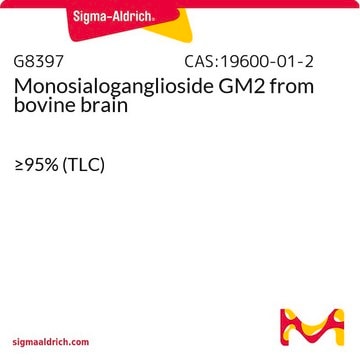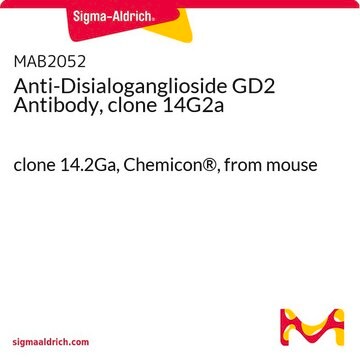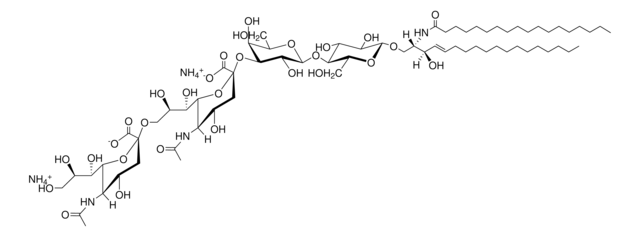G0776
Disialoganglioside-GD2 from bovine brain
~95%, lyophilized powder, semisynthetic
About This Item
Empfohlene Produkte
Qualitätsniveau
Assay
~95%
Form
lyophilized powder
Lagertemp.
−20°C
InChI
1S/C74H134N4O32/c1-4-6-8-10-12-14-16-18-19-21-23-25-27-29-31-33-52(89)78-43(44(84)32-30-28-26-24-22-20-17-15-13-11-9-7-5-2)40-101-69-61(95)60(94)63(50(38-81)104-69)106-70-62(96)67(64(51(39-82)105-70)107-68-55(77-42(3)83)59(93)58(92)49(37-80)103-68)110-74(72(99)100)35-46(86)54(76)66(109-74)57(91)48(88)41-102-73(71(97)98)34-45(85)53(75)65(108-73)56(90)47(87)36-79/h30,32,43-51,53-70,79-82,84-88,90-96H,4-29,31,33-41,75-76H2,1-3H3,(H,77,83)(H,78,89)(H,97,98)(H,99,100)/b32-30+/t43?,44?,45-,46-,47?,48?,49-,50-,51-,53+,54+,55-,56?,57?,58+,59-,60-,61-,62-,63-,64+,65+,66+,67-,68+,69-,70+,73-,74+/m1/s1
InChIKey
FFILOTSTFMXQJC-QCFYAKGBSA-N
Verwandte Kategorien
Amino Acid Sequence
Allgemeine Beschreibung
Anwendung
- in the ganglioside- enzyme-linked immunosorbent assay (ELISA)
- in capture ELISA with anti-GD2 antibody (ch14.18)
- as a control to test its effect on reactivating autophagy in primary fibroblasts
Biochem./physiol. Wirkung
Lagerklassenschlüssel
11 - Combustible Solids
WGK
WGK 3
Flammpunkt (°F)
Not applicable
Flammpunkt (°C)
Not applicable
Persönliche Schutzausrüstung
Eyeshields, Gloves, type N95 (US)
Analysenzertifikate (COA)
Suchen Sie nach Analysenzertifikate (COA), indem Sie die Lot-/Chargennummer des Produkts eingeben. Lot- und Chargennummern sind auf dem Produktetikett hinter den Wörtern ‘Lot’ oder ‘Batch’ (Lot oder Charge) zu finden.
Besitzen Sie dieses Produkt bereits?
In der Dokumentenbibliothek finden Sie die Dokumentation zu den Produkten, die Sie kürzlich erworben haben.
Unser Team von Wissenschaftlern verfügt über Erfahrung in allen Forschungsbereichen einschließlich Life Science, Materialwissenschaften, chemischer Synthese, Chromatographie, Analytik und vielen mehr..
Setzen Sie sich mit dem technischen Dienst in Verbindung.








